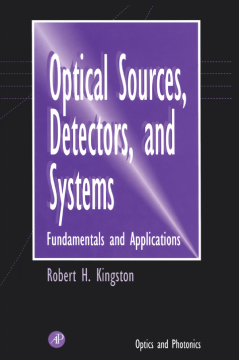
Additional Information
Book Details
Abstract
Optical Sources, Detectors, and Systems presents a unified approach, from the applied engineering point of view, to radiometry, optical devices, sources, and receivers. One of the most important and unique features of the book is that it combines modern optics, electric circuits, and system analysis into a unified, comprehensive treatment.
The text provides physical concepts together with numerous data for sources and systems and offers basic analytical tools for a host of practical applications. Convenient reference sources, such as a glossary with explanatory text for specialized optical terminology, are included. Also, there are many illustrative examples and problems with solutions. The book covers many important, diverse areas such as medical thermography, fiber optical communications, and CCD cameras. It also explains topics such asD *, NEP, f number, RA product, BER, shot noise, and more.
This volume can be considered an essential reference for research and practical scientists working with optical and infrared systems, as well as a text for graduate-level courses on optoelectronics, optical sources and systems, and optical detection. Aproblem solution manual for instructors who wish to adopt this text is available.
- Provides a unified treatment of optical sources, detectors, and applications
- Explains D *, NEP, f number, RA product, BER, shot noise, and more
- Contains numerous illustrative examples and exercises with solutions
- Extensively illustrated with more than 90 drawings and graphs
"While the book emphasizes the fundamentals, it succeeds in covering a broad scope of topics well. Nearly every reader will find something new and useful here....In short, Optical Sources, Detectors, and Systems: Fundamentals and Applications is an excellent guide to designing and understanding radiometric systems and will be useful for students and systems engineers alike. It is practical, thorough, and a pleasure to read." --OPTICS AND PHOTONICS NEWS
